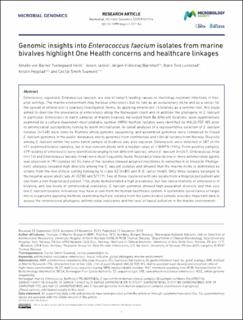| dc.description.abstract | Enterococci, especially Enterococcus faecium, are one of today’s leading causes of multidrug-resistant infections in hospital settings. The marine environment may harbour enterococci, but its role as an evolutionary niche and as a vector for the spread of enterococci is sparsely investigated. Hence, by applying enterococci in bivalves as a sentinel tool, this study aimed to describe the prevalence of enterocooci along the Norwegian coast and in addition the phylogeny of E. faecium in particular. Enterococci in batch samples of marine bivalves, harvested from 86 different locations, were quantitatively examined by a culture-dependent most probable number (MPN) method. Isolates were identified by MALDI-TOF-MS prior to antimicrobial susceptibility testing by broth microdilution. In-detail analyses of a representative selection of E. faecium isolates (n=148) were done by Illumina whole-genome sequencing, and assembled genomes were compared to closed E. faecium genomes in the public databases and to genomes from commensal and clinical isolates from Norway. Diversity among E. faecium within the same batch sample of bivalves was also explored. Enterococci were detected in 287 of the 471 examined bivalve samples, but in low concentrations with a median value of <18 MPN /100 g. From positive samples, 479 isolates of enterococci were identified belonging to ten different species, where E. faecium (n=247), Enterococcus hirae (n=114) and Enterococcus faecalis (n=66) were most frequently found. Resistance towards one or more antimicrobial agents was observed in 197 isolates (41 %), none of the isolates showed acquired resistance to vancomycin or linezolid. Phylogenetic analyses revealed high diversity among the E. faecium isolates and showed that the marine niche is dominated by strains from the non-clinical setting belonging to clade A2 (n=85) and B (E. lactis) (n=60). Only three isolates belonged to the hospital-associated clade A1 (ST80 and ST117). Two of these clustered with one isolate from a hospitalized patient and one from a non-hospitalized person. This study demonstrated a high prevalence, but low concentrations of enterococci in bivalves, and low levels of antimicrobial resistance. E. faecium genomes showed high population diversity and that very few E. faecium isolates in bivalves may have arisen from the human healthcare system. A systematic surveillance of target micro-organisms applying methods examining multiple isolates from the same bivalve sample provides important data to assess the enterococcal phylogeny, antimicrobial resistance and the level of faecal pollution in the marine environment. | en_US |
